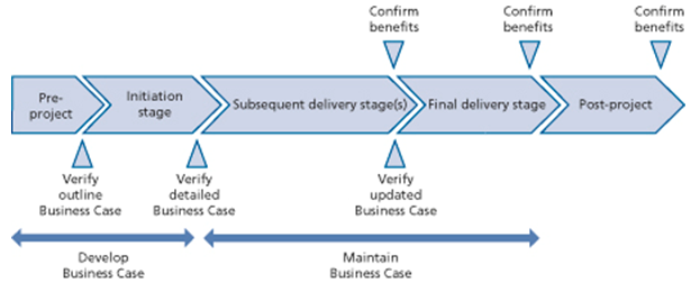Business Case
| Line 4: | Line 4: | ||
=What is a Business Case= | =What is a Business Case= | ||
=Types of Business Cases= | =Types of Business Cases= | ||
| − | == | + | =Defining a Business Case= |
| + | ==Executive Summary== | ||
| + | ==Reasons== | ||
| + | ==Business Options== | ||
| + | ==Expected Benefits== | ||
| + | ==Expected Drawbacks== | ||
| + | ==Timescale== | ||
| + | ==Cost== | ||
| + | ==Investment Appraisal== | ||
| + | ==Major Risks== | ||
| + | =Responsibilities= | ||
| + | =Relevant Tools= | ||
| + | =Limitations= | ||
| + | |||
| Line 30: | Line 43: | ||
The Business Case should include a summary of the aggregated risks (and it is suggested that this is in the form of a summary risk profile) and highlight the major risks that will have an effect on the business objectives and benefits (therefore covering both the project delivery and the ongoing operations and maintenance). For example, the risks for the office relocation could include unforeseen moving costs (e.g. asbestos removal) or impact on business continuity (e.g. loss of key staff unwilling to relocate). | The Business Case should include a summary of the aggregated risks (and it is suggested that this is in the form of a summary risk profile) and highlight the major risks that will have an effect on the business objectives and benefits (therefore covering both the project delivery and the ongoing operations and maintenance). For example, the risks for the office relocation could include unforeseen moving costs (e.g. asbestos removal) or impact on business continuity (e.g. loss of key staff unwilling to relocate). | ||
| − | + | =References= | |
<references> | <references> | ||
Revision as of 14:49, 12 February 2018
This article treats the subject Business Case within project management. The definitions of Business Case are discussed with its limitiations. Business Case is the document that defines whether or not a project is worth undertaking from the company perspective. A Business Case can be either pre-defined from a corporate level or initiated at project start. The article will discuss relevant tools to Business Case and the relevant responsibilities when creating or working with a Business Case. The Business case is defined by Murray,(2009)[1] as a document that presents the optimum mix of information used to judge whether a project is desirable, viable and achievable, and therefore worthwhile investing in.
Contents |
What is a Business Case
Types of Business Cases
Defining a Business Case
Executive Summary
Reasons
Business Options
Expected Benefits
Expected Drawbacks
Timescale
Cost
Investment Appraisal
Major Risks
Responsibilities
Relevant Tools
Limitations
Big Idea
The purpose of the business case is to establish a basis for judging whether the project is and remains desirable, viable and achievable as a means to support decision making in its continued investment.
Application
A Business case can be used to determine whether a project justifies to be invested in. It is a static process which should be maintained through the project and it should continuously be updated with current information on costs, risks and benefits.
Below is the figure of the development path of a business case from PRINCE2.
It is seen that after each step there is a milestone of verifying and/or confirming to make sure that the Business Case is up to date, and that it is first after the final delivery stage that the Business Case stops being updated and used.
Limitations
Any opportunity is likely to be offset by an element of risk. Therefore in order to make the judgement of ’business justification’, the Project Board needs to understand not only the benefits and the project costs, but the set of risks that may either reduce/enhance the benefits or reduce/increase the cost.
The Business Case should include a summary of the aggregated risks (and it is suggested that this is in the form of a summary risk profile) and highlight the major risks that will have an effect on the business objectives and benefits (therefore covering both the project delivery and the ongoing operations and maintenance). For example, the risks for the office relocation could include unforeseen moving costs (e.g. asbestos removal) or impact on business continuity (e.g. loss of key staff unwilling to relocate).
References
- ↑ Murray, Andy & Co. (2009), Managing successful projects with PRINCE2, 5th edition, p. 21, United Kingdom, TSO.
Annotated Bibliography
Further reading about the template for making a Business case: http://www.projectmanagementdocs.com/project-initiation-templates/business-case.html#axzz4XoPzbU80
Murray, Andy & Co. (2009), Managing successful projects with PRINCE2, 5th edition, p. 21-28, United Kingdom, TSO.
Annotation: The book has a seven page chapter about Business Case, and describes in details how to develop it.
Maylor, H. (2010). Project Management, Pearson Education ltd, 4th edition, p.184-191, GB, ISBN: 9780273704324
Annotation: The development of a Business Case is explaned in seven pages with different examples and descriptions.
